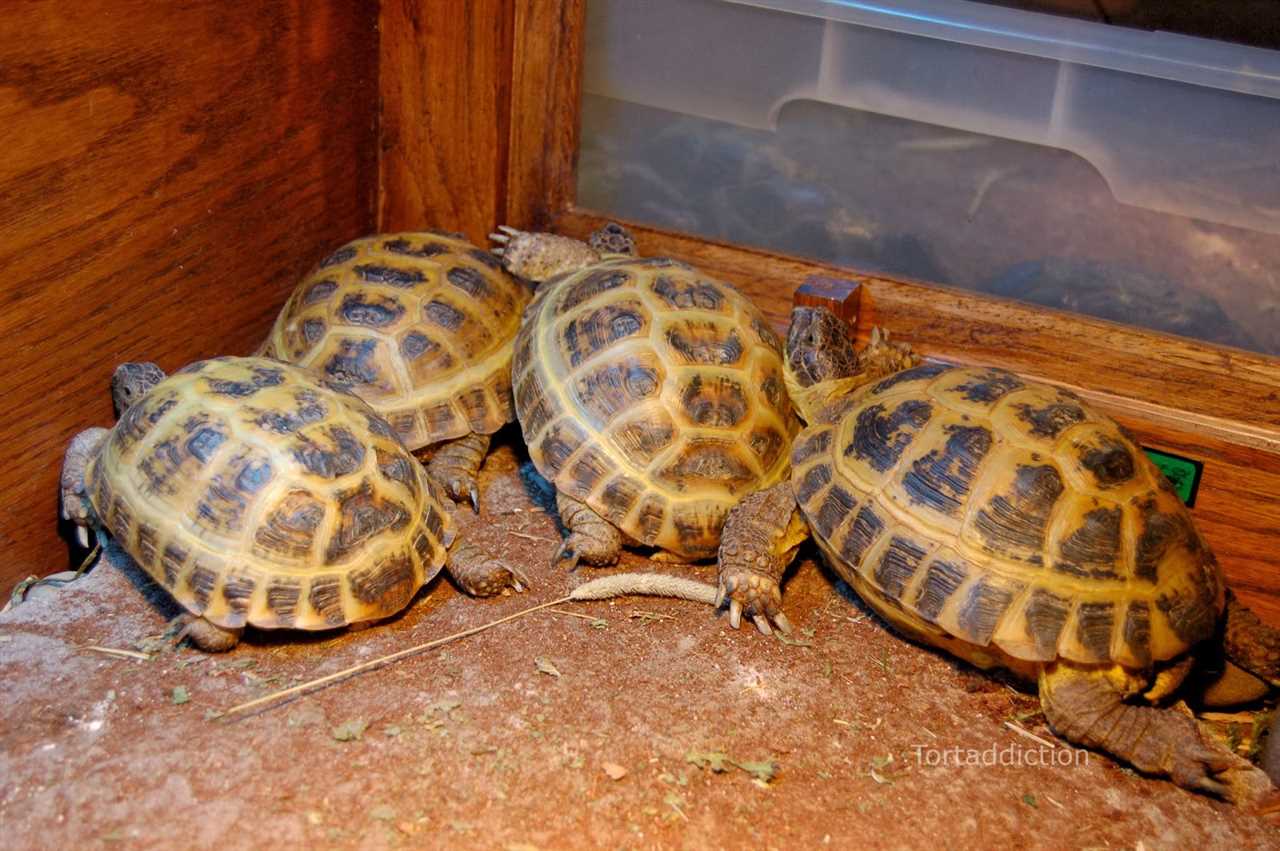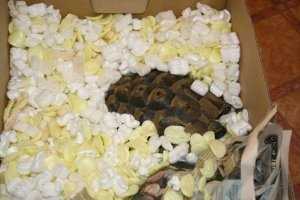
Winter is a time when many animals, including reptiles, go into a deep sleep called hibernation. Russian tortoises are no exception. These small, cold-blooded creatures are native to arid regions of Central Asia, where they have adapted to survive harsh winters by hibernating.
Hibernation is a natural process that helps reptiles conserve energy and survive in cold temperatures. During this period, the Russian tortoise’s metabolism slows down, and its body temperature drops. They find a cozy spot in their enclosure or outdoor pen, dig a burrow, and go into a deep slumber for several months.
Russian Tortoise Hibernation: How to Prepare Your Pet for Winter

The Sleep of the Tortoise: Hibernation

During hibernation, the tortoise enters a deep sleep-like state where its metabolic rate slows down significantly. This allows it to conserve energy and survive without eating for an extended period. The tortoise prefers to burrow deep into the ground, where it creates a natural shelter to protect itself from the cold temperature.
1. Temperature and Light
The first step in preparing your tortoise for hibernation is to gradually decrease the temperature in its enclosure over a period of several weeks. The ideal temperature for hibernation is around 45-55 degrees Fahrenheit (7-13 degrees Celsius). This can be achieved by placing the tortoise in a cool room or using a thermostat-controlled heater.
It is crucial to provide a gradual decrease in temperature to avoid shocking the tortoise. Sudden changes in temperature can be harmful to its health.
2. Preparing the Hibernation Burrow
A hibernation burrow provides the necessary protection and insulation for your tortoise during its deep sleep. The burrow should be deep enough to allow the tortoise to fully bury itself but not too deep to restrict its movement.
You can create a hibernation burrow by digging a shallow trench in a corner of its enclosure or using a separate container filled with a mix of soil, sand, and peat moss. Make sure to keep the burrow slightly moist to maintain the proper humidity level.
Place the tortoise in the burrow and cover it with a layer of loose substrate. This will help maintain a stable temperature and provide insulation. Always ensure that the burrow is well-ventilated to prevent the accumulation of harmful gases.
3. Monitoring Your Tortoise’s Health
If you notice any abnormalities or concerns, it is recommended to consult a veterinarian who specializes in reptiles.
By providing the right environment and monitoring your tortoise’s health, you can ensure a successful hibernation period for your pet Russian tortoise. Remember to gradually wake up your tortoise from hibernation when the weather starts to warm up to avoid shocking its system.
During hibernation, the tortoise’s body temperature drops significantly. It enters a state of torpor, where its bodily functions slow down, and it becomes unresponsive. The goal is to maintain a stable and cool environment for the tortoise, mimicking the conditions it would experience in the wild.
| Key Points: |
| – Hibernation is a natural process for Russian tortoises and allows them to conserve energy during the cold winter months. |
| – Hibernation is triggered by the changing seasons and the decrease in temperature. |
| – During hibernation, the tortoise’s body temperature drops significantly, and its bodily functions slow down. |
| – Not all reptiles can safely undergo hibernation, so it is crucial to research the specific requirements of your Russian tortoise. |
Creating the Perfect Hibernation Environment

Next, you will need to prepare a burrow for your tortoise to sleep in during hibernation. This burrow should be large enough for your pet to comfortably fit in, while also providing enough space for it to turn around. It is recommended to use a large plastic container or a wooden box lined with a soft material, such as straw or hay.
The temperature within the burrow must be monitored closely to ensure it remains within the appropriate range. You can use a reliable thermometer to check the temperature regularly. If it goes above or below the desired range, you may need to make adjustments, such as adding or removing insulation.
Lastly, it is crucial to provide proper ventilation within the hibernation environment. This will prevent the buildup of carbon dioxide and excessive moisture, which can be harmful to your tortoise. You can achieve this by creating small holes in the lid or sides of the container or box.
Adjusting Your Pet’s Diet
Firstly, it is crucial to gradually reduce the amount of food your tortoise consumes in the weeks leading up to hibernation. This will help prepare their digestive system for the long period of reduced activity. Start by gradually reducing the portion sizes and the frequency of feeding. Monitor your tortoise’s weight to ensure that they are not losing too much body mass.
It is also recommended to provide the tortoise with a calcium supplement during the hibernation period to ensure they maintain healthy bone development. Calcium supplements can be found in pet stores and should be provided according to the instructions on the packaging.
By adjusting your pet’s diet appropriately, you will ensure that they have the necessary nutrients to support their health and well-being during hibernation.
Monitoring Your Tortoise’s Health
Sleep Patterns
Check on your tortoise regularly to observe its sleep patterns. While in hibernation, the tortoise’s metabolism slows down significantly, and its body temperature drops. This is a normal and necessary part of the hibernation process. However, if you notice any unusual behavior, such as extended periods of wakefulness or excessive lethargy, it could be a sign of a health issue.
Weight Loss
Regularly weigh your tortoise throughout the hibernation period. It’s normal for the tortoise to lose some weight during hibernation due to the reduced activity and decreased intake of food. However, if you notice a significant and rapid weight loss, it could indicate an underlying health problem. In such cases, it’s best to seek veterinary advice.
Respiration Rate
Monitor your tortoise’s respiration rate during hibernation. It should be slow and regular. Any rapid or irregular breathing patterns could be a sign of respiratory distress or infection. In such cases, it’s essential to consult with a reptile veterinarian for proper diagnosis and treatment.
Physical Examination
Perform a physical examination of your tortoise before and after hibernation. Check for any abnormalities, such as injuries or infections. Pay specific attention to the eyes, mouth, limbs, and shell. If you notice any wounds, discharge, swelling, or other concerning symptoms, seek veterinary attention promptly.
| Signs of a Healthy Hibernating Tortoise | Signs of a Sick Hibernating Tortoise |
|---|---|
| – Slow and regular breathing | – Rapid or irregular breathing |
| – Gradual weight loss | – Rapid and significant weight loss |
| – Deep sleep and limited movement | – Extended periods of wakefulness or excessive lethargy |
| – Slightly cooler body temperature | – Abnormal body temperature (too cold or too warm) |
Remember, it’s crucial to provide your Russian tortoise with the necessary care and attention during the hibernation period. Regular monitoring of its health and consulting with a reptile veterinarian as needed will help ensure a successful and safe hibernation for your pet.
Tips for Successful Hibernation
- Choose the right location: Find a suitable location for your tortoise to hibernate, such as a cool and dark place. A temperature between 35-50°F (1-10°C) is ideal for the hibernation period.
- Prepare a proper burrow: Create a burrow for your tortoise to mimic their natural habitat. It should be deep enough for them to fully hide and should provide insulation from the cold temperatures outside.
- Maintain a stable temperature: Ensure that the temperature in the hibernation area remains constant throughout the winter. Fluctuations in temperature can disrupt the hibernation process and potentially harm your tortoise.
- Limit disturbances: Keep interactions with your tortoise to a minimum during hibernation. Disturbing them can cause them to wake up from their deep sleep, which can be harmful to their health.
- Monitor weight loss: It is normal for tortoises to lose some weight during hibernation. However, excessive weight loss can indicate a problem. Weigh your tortoise periodically to ensure they are healthy and maintaining an appropriate weight.
- Stay vigilant: Regularly check on your tortoise throughout the hibernation period. Look for any signs of illness or distress, such as unusual behavior, lack of movement, or abnormal discharge. If you notice anything concerning, consult a veterinarian immediately.
- Gradually bring them out of hibernation: When the winter season is over and the temperatures start to rise, it’s time to wake your tortoise from hibernation. Do this gradually by slowly increasing the temperature in their hibernation area. This will help them adjust to the warmer temperatures and avoid any shocks to their system.
By following these tips, you can ensure a successful hibernation period for your tortoise and help them stay healthy throughout the winter.
Waking Your Tortoise from Hibernation

When your tortoise has been in hibernation, its body temperature drops significantly, and its metabolic functions slow down. Before waking your tortoise, it’s crucial to make sure the environment is warm enough. Gradually increasing the temperature over a period of several days will help mimic the natural conditions that would signal the end of winter.
A good way to determine if it’s time to wake your tortoise is by monitoring the temperature inside its burrow or hibernation box. Once the temperature begins to rise steadily and consistently, it is an indication that your pet is ready to wake up. This gradual increase in temperature will help prevent any sudden shocks or stress to their system.
During the waking process, closely monitor your tortoise’s health and behavior. Look for any signs of illness or distress, such as lethargy, abnormal breathing, or lack of appetite. If you notice any concerning symptoms, it is recommended to consult a veterinarian who specializes in reptiles.
Allow your tortoise some time to acclimate to their waking state before reintroducing them to their regular habitat. Keep them in a warm and controlled environment for a few days to help them fully recover from hibernation and regain their strength.
Remember, the waking process should be done gradually and with care to ensure the well-being of your tortoise. By following these steps, you can help your Russian tortoise transition smoothly from hibernation to an active and healthy state.
